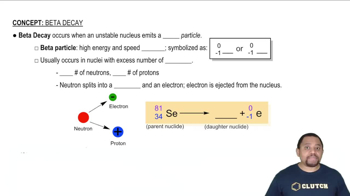The decomposition of XY is second order in XY and has a rate constant of 7.02⨉10-3 M-1• s-1 at a certain temperature. a. What is the half-life for this reaction at an initial concentration of 0.100 M?
Ch.15 - Chemical Kinetics

Chapter 15, Problem 63a
The half-life for the radioactive decay of U-238 is 4.5 billion years and is independent of initial concentration. How long will it take for 20% of the U-238 atoms in a sample of U-238 to decay?
 Verified step by step guidance
Verified step by step guidance1
Identify that the problem involves first-order kinetics, as radioactive decay follows first-order kinetics.
Use the first-order decay formula: \( N_t = N_0 e^{-kt} \), where \( N_t \) is the remaining quantity of substance, \( N_0 \) is the initial quantity, \( k \) is the decay constant, and \( t \) is time.
Determine the decay constant \( k \) using the half-life formula for first-order reactions: \( k = \frac{0.693}{t_{1/2}} \), where \( t_{1/2} \) is the half-life.
Calculate the time \( t \) it takes for 20% of the U-238 to decay, meaning 80% remains, using the rearranged decay formula: \( t = \frac{1}{k} \ln \left( \frac{N_0}{N_t} \right) \).
Substitute the values into the equation: \( t = \frac{1}{k} \ln \left( \frac{100}{80} \right) \) to find the time it takes for 20% of the U-238 to decay.

Verified video answer for a similar problem:
This video solution was recommended by our tutors as helpful for the problem above.
Was this helpful?
Key Concepts
Here are the essential concepts you must grasp in order to answer the question correctly.
Half-life
Half-life is the time required for half of the radioactive nuclei in a sample to decay. It is a constant property of each radioactive isotope, meaning it does not change regardless of the amount of substance present. For U-238, the half-life is 4.5 billion years, indicating that after this period, half of the original amount will have transformed into a different element.
Recommended video:
Guided course

Zero-Order Half-life
Radioactive Decay
Radioactive decay is a stochastic process by which unstable atomic nuclei lose energy by emitting radiation. This process results in the transformation of the original isotope into a different element or isotope. The decay occurs at a predictable rate characterized by the half-life, allowing for calculations of how much of a substance remains after a given time.
Recommended video:
Guided course

Rate of Radioactive Decay
Exponential Decay
Exponential decay describes the process by which a quantity decreases at a rate proportional to its current value. In the context of radioactive decay, this means that the number of undecayed nuclei decreases exponentially over time. The relationship can be expressed mathematically, allowing for the determination of the remaining quantity of a substance after a specific duration, such as calculating the time required for a certain percentage of decay.
Recommended video:
Guided course

Beta Decay
Related Practice
Textbook Question
Textbook Question
The half-life for the radioactive decay of U-238 is 4.5 billion years and is independent of initial concentration. If a sample of U-238 initially contained 3.2⨉1018 atoms when the universe was formed 13.8 billion years ago, how many U-238 atoms does it contain today?
Textbook Question
The half-life for the radioactive decay of C-14 is 5715 years and is independent of the initial concentration. How long does it take for 25.00% of the C-14 atoms in a sample of C-14 to decay?
Textbook Question
The half-life for the radioactive decay of C-14 is 5715 years and is independent of the initial concentration. If a sample of C-14 initially contains 1.5 mmol of C-14, how many millimoles are left after 2725 years?
